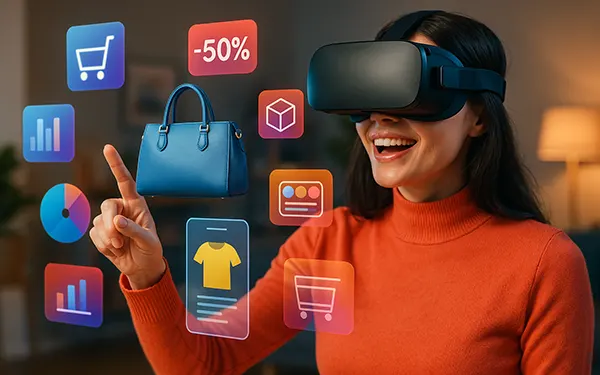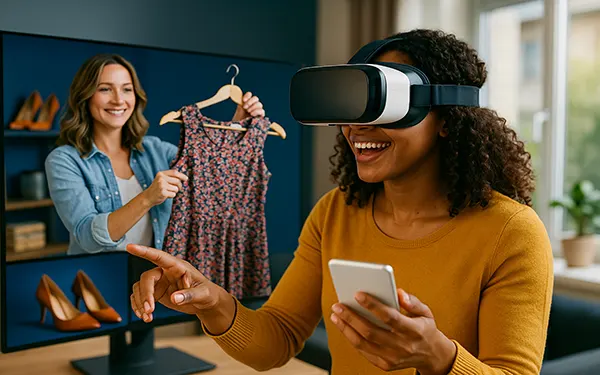
The Impact of Virtual and Augmented Reality on Digital Marketing
Virtual Reality (VR) and Augmented Reality (AR) have revolutionised the way marketers engage with their audience. These technologies provide immersive experiences that allow brands to interact directly with customers, creating deeper connections and enhancing consumer loyalty. As of February 2025, the significance of VR and AR in digital marketing has reached unprecedented heights, shaping new strategies and innovative approaches across various sectors.
Transforming Consumer Experiences through VR and AR
One of the most notable impacts of VR and AR in digital marketing is the transformation of consumer experiences. With VR, users can participate in virtual store visits, product trials, and interactive demonstrations, giving them comprehensive insights into products without needing physical presence. For instance, leading automotive brands such as BMW and Audi are employing VR technology to provide virtual test drives, significantly enhancing user experience and satisfaction.
Similarly, AR allows consumers to visualise products within their real-world context, significantly improving their purchasing decisions. Brands such as IKEA and Sephora have successfully adopted AR, enabling customers to virtually place furniture within their homes or try cosmetic products without physically visiting stores. Such personalised experiences foster higher engagement rates and boost conversions.
Moreover, VR and AR provide powerful storytelling tools that brands leverage to create emotionally compelling narratives. Campaigns enriched with these technologies can convey brand messages in an interactive, memorable manner. By combining creativity and technology, marketers effectively capture consumer attention and inspire long-lasting brand relationships.
Enhanced Product Personalisation with AR
Augmented Reality significantly enhances product personalisation, enabling consumers to customise and visualise their choices instantly. This interactive capability has particularly impacted industries like fashion and home décor, where customers desire a high level of personalisation before making a purchase. By integrating AR tools within their digital marketing campaigns, brands deliver tailored experiences that directly respond to customer preferences.
Fashion retailers, including Nike and Gucci, utilise AR to offer virtual fitting rooms, allowing users to see how clothing or accessories look on them in real-time. Such immersive experiences not only elevate customer satisfaction but also reduce returns and increase buyer confidence, directly impacting profitability.
In home furnishing, AR empowers consumers to experiment with different styles, colours, and placements effortlessly. This convenience has proven effective in eliminating hesitation during purchases, leading to more informed decisions and greater consumer satisfaction. Consequently, AR-driven personalisation has become a cornerstone of successful digital marketing strategies.
VR and AR in Influencer and Social Media Marketing
Influencer marketing has witnessed significant advancements with the introduction of VR and AR. Influencers now have sophisticated tools at their disposal to create highly engaging and interactive content. Platforms such as Instagram and Snapchat integrate AR features, providing influencers opportunities to produce visually striking and interactive posts that captivate their audiences.
The interactive nature of AR filters and VR experiences has amplified audience engagement and boosted brand visibility on social media platforms. Brands collaborate with influencers to create customised AR experiences, leading to higher user interaction and extended audience reach. For instance, fashion and beauty influencers leverage AR filters to showcase new products creatively, increasing brand exposure and audience interaction.
Furthermore, social media campaigns using VR technology offer immersive live events and virtual meet-and-greets, significantly enhancing audience participation. The ability to connect virtually but realistically strengthens brand-influencer partnerships and fosters deeper relationships between brands and consumers.
Improved Metrics and Data Analytics
The integration of VR and AR in digital marketing significantly enhances the capability to measure and analyse consumer interactions. These advanced technologies generate precise metrics on user behaviour, preferences, and engagement, enabling marketers to gain detailed insights into consumer journeys. This data is invaluable for refining future campaigns and delivering targeted, personalised content.
Through AR interactions, brands can track exactly how customers interact with products in real-time, collecting data on preferred colours, styles, and functionalities. Such detailed metrics inform strategic decisions, helping brands adapt quickly to consumer trends and demands. The result is highly effective marketing strategies tailored directly to consumer insights and expectations.
Similarly, VR analytics offer comprehensive data on customer experiences and emotional responses. Marketers analyse user interaction within virtual environments, allowing them to fine-tune future marketing efforts for maximum impact. As digital marketing becomes increasingly data-driven, VR and AR provide essential tools for precise, measurable results.

Future Trends and Opportunities
The future of digital marketing with VR and AR promises further innovation and expansion. Emerging developments, such as improved hardware accessibility and advancements in immersive technology, suggest that adoption rates will continue to rise significantly. As these technologies become more user-friendly and cost-effective, even small businesses will increasingly incorporate VR and AR into their marketing strategies.
Additionally, with ongoing advancements in AI integration, VR and AR experiences will become more intuitive and personalised. AI-driven AR applications are anticipated to offer real-time customised recommendations, significantly enhancing consumer satisfaction and loyalty. Brands that leverage these future innovations early will gain significant competitive advantages.
Lastly, the widespread adoption of 5G technology will dramatically boost the capabilities of VR and AR, reducing latency and enhancing experience fluidity. This technological synergy will unlock unprecedented potential for marketers, enabling richer, more engaging, and seamlessly interactive experiences that meet and exceed customer expectations.
Preparing for VR and AR Adoption
For marketers preparing to integrate VR and AR into their strategies, it’s crucial to begin by understanding their audience’s technology readiness. Developing user-friendly applications and ensuring seamless integration into existing platforms are fundamental to successful implementation. Continuous testing, user feedback, and iterative improvements will help brands optimise the effectiveness of their immersive campaigns.
Training marketing teams on emerging VR and AR tools is equally essential. Knowledgeable marketers equipped with the right skills can fully exploit these technologies, creatively and effectively delivering immersive campaigns. Investing in talent and technical capabilities will ensure sustained success in digital marketing.
Finally, staying informed about industry developments, attending technology expos, and actively collaborating with innovative tech partners will position brands strategically. Early adopters that continually innovate and refine their approach to VR and AR marketing are best placed to succeed in the evolving digital landscape.
